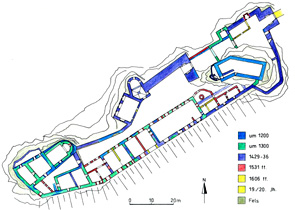|
Structural specifications |
The castle was built on top a 150m high
west-easterly orientated sandstone rock shelf. High belays border both
lathy ends of the rock shelf and steeply descend towards the Danube river
on three sides.
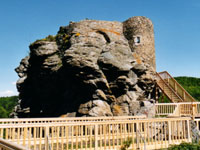 |
However, on the eastern side the terrain rises so
steeply that the castle seems considerably excessive even from a
short distance, causing it to become vulnerable from a strategic
point of. The smaller of the two belays called “Bürgel”,
rises like a shield towards the endangered side.
|
The larger and higher belay situated
towards the western end of the castle was named “Stein”. The
outer bailey (“Vorburg”) which originally was safeguarded by a ditch
cutting of the neck of the promontory (“Halsgraben”), was formally located
in an open space in front of the castle encircling the southern part of
the main castle. Only two estate buildings of the 16th/17th
centuries have been preserved. The old castle path, rising high on the
northern side of the castle, is still known as “Mule’s Path”
(“Eselssteig”) today.
A ramp thrown up in the 19th cent. crosses the former ditch
which did cut off the promontory. It leads to the outer gate of the
main castle protruding a massive block of masonry of 8 meters
thickness which – according to old depictions – once bore a wooden
superstructure. At the same time the adjacent curtain wall built towards
the southern side was erected creating a wide circle around the „Bürgel“
and ending in a battlement with loopholes for hakebuts, built in 1531.
Just behind the gateway the Gatekeepers’s abode (“Torwarthaus”) was built
(5th phase of
construction respectively in 1606 sqq.) which nowadays
accommodates the ticket office and the castle souvenir shop.
The following defensive reinforcement section which was incorporated
around 1300 (2nd
phase of construction) is at the rear end of the Gatekeeper’s
abode (“Torwarthaus”) and belongs to the second gateway building.
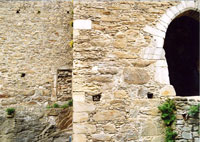 |
This gateway, similar to the 1st,
has a large pointed arch with a small gate for pedestrians, which
was built during the course of the recent reinforcements done in
1531. The construction of the gateway allowed the integration of a
concave chamber with a 4m deep cellar, which, because of the
appearance of its entrance (“Angstloch”), was mistaken for a dungeon. |
The 3rd and inner gateway
is located inside a hook-shaped shielded wall with a nominal diameter of
4-5m and height of 12m. The inscription is still clearly legible, it reads
that a certain Jörg Scheck vom Wald had commenced with the restorations of
the dilapidated castle on the 12th September 1429 (“the Monday after the
birth of Holy Mary”). Towards the southern part, aside from the gateway,
the solid wall block is penetrated by an older wall fragment dating from
the 1st phase
of construction, thus bearing witness to the former existence of
an older gateway in the exact same place.
|
After passing through the 3rd
gateway one reaches the small central courtyard, the so called
“Mittelhof”, stretching across the area between the two belays, the
„Bürgel“ and the „Stein“. Forming part of the highly dense vicinity
is a cistern banged into the foot of the „Bürgel“-rock. The
southern front of the central courtyard is occupied by a hall
building of 50 m length which contains a hall of 23 x 9 m. This
has been restored in 2004/05 as a festive hall after having been
altered several times. The entire wing including the festive hall
already did exist in the
1st phase
of construction (around 1200). During the
3rd phase
of construction (around 1429-36) vaults were integrated into
the basement, as well as it being extended by a cellar towards the
western side. |
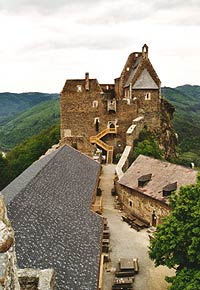 |
Nowadays the impressive cellar vaults
with their big pillars serve as an exhibition hall and accommodate an
amusing theatrical staging of the Nibelungen saga.
The well tower („Brunnenturm“) is a polygonal corpus which encloses
the castle fountain and is situated towards the eastern side of the great
hall. The building, together with the fountain and the smithy, on the
eastern side, originate from the
4th phase of
construction (around 1531). The beautiful renaissance window found
in the great hall caused confusion concerning the determination of the
date of construction of the hall. The very unusual type of window for that
time period is situated on the walls facing the court yard and is thus
merely an addition made in the 1st half of the 19th
century. The smithy, a
single storey arched building which is located adjacent to the eastern
side, is in fact a bakery which was built simultaneously to the well tower
(„Brunnenturm“). Even the oven inside which also functioned as a heater
for both small rooms has been well preserved. The castle kitchen with its
enormous pentagonal pyramid-shaped chimney is situated opposite the great
hall. The kitchen, its original dichotomy, which includes a back
room with dishwashing and cooking facilities such as a sink and a large
stove under a wide chimney and a front room, (which were all constructed
at the same time as the northern wall in the
3rd phase of construction)
was all completely preserved.
The old service window facing the courtyard still maintains its
picturesque appearance and the old kitchen still fulfils its original
function until today. The house for the courtiers (“Dürnitz”) next
to the kitchen, which originally served as the recreational and dining
room for the residence of the castle, which since its restoration in 1922,
functions as a guest room and castle tavern. A magnificent view over the
Danube and Wachau rivers can be enjoyed from the windows of the room,
which used to have separate doors to the kitchen and the courtyard. The
courtyard narrows down in certain places towards the upper castle and
“Stein” to a width of 4-5m. This also marks the spot where an older
fragment of the curtain wall (from the
1st phase of
construction) can be found in the northern wall.
Towards the east the central courtyard is surmounted by the steep rock of
the “Bürgel”.
|
The foundations of an edgeless
angular building which already existed in the
1st phase
of construction (around 1200), are clearly visible.
The drawing done by Wolf Huber dating from 1542, shows a
double-storey Fortified House (“Feste Haus “). The entrance could be
reached from the southern side by climbing over bridges, ladders and
steps hammered into the rock. Scheck vom Wald incorporated a small
barbican into the Fortified House and reinforced it with a small
tower (1429-36, 3rd
phase of construction). |
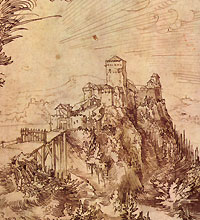 |
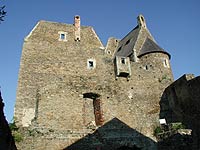 |
The upper castle - situated on the
belay called „Stein“ - dominates the entire central castle
and overlooks the long and winding Danube river far down below. The
towering front façade of the stronghold is distinguished by its
tremendous architectural vitality and power. |
The elevated entrance with its opening
inside the stronghold, facing the panel of the drawbridge and the jutty,
is encompassed by the enormous buildings of the Maidens’ Tower and the
castle’s chapel. Originally the elevated entrance could be reached by a
wooden gallery, ascending from the courtyard along the northern wall.
Ending at the rock wall of the “Stein” a short runway leads to almost
before the elevated entrance before disappearing into nothingness. One
could only access the castle porch through the opened drawbridge.
|
The elevated entrance was built
together with the central zone in the
3rd phase of
construction (1429-36), whereas the Maidens’ Tower
represents a typical residential tower of the 14th
century. With 3 of its walls the enormous tower resting on older
foundations, dating back from the
1st phase
of construction (around 1200), it also used to have a
slightly larger expansion towards the west. Gaining its current
shape and dimensions in the
2nd phase of
construction around 1300 as well as in the
3rd phase.
As two additional storeys were built, a dichotomy was formed by the
integration of the internal walls and wide openings for new windows
over the flying arches. |
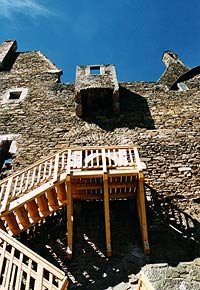 |
The inside of the castle was remodelled
by barricading the flying arches and by incorporating new internal walls,
massive wooden stairs, a wooden and several privies, this occurring during
the 4th phase
of construction (around 1531). Chimneys suggest former heatability
of the castle.
Only a few metres next to the Maidens’ Tower, a loophole gate leads from
the narrow courtyard of the Stein to the outside of the castle, which only
steeply declines well down below. The backdoor was barricaded during the 4th
phase of construction (around 1531) when a small vault was erected instead.
|
Blocky-fishbone-shaped bricks that were used in the
1st phase
of construction are to some extent found in the northern
block of buildings, consisting of the chapel and the great hall
(„Palas“). Giving evidence to the existence of previous buildings
with almost similar dimensions being built here before.
|
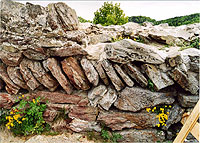 |
Nowadays, accessibility to the chapel
and the great hall is attained by a short wooden staircase. During the
1st phase of
construction the Castle Chapel consecrated to the Saints
George and Koloman, already had a somewhat larger but identically shaped
predecessor with a slightly rectangular nave and round apsis. The ground
floor dates back to the 2nd
phase of construction (around 1300), the upper part dating back to
the 3rd phase
(around 1429-36) and today’s pointed windows belonging to the
4th –
evidently manifesting each phase of construction. Supposedly, 1113 which
was formerly painted on the triumphal arch was mistakenly considered to be
the year of establishment of the castle – the date was derived from Arabic
numerals, thus being an interpretational error because such numerals were
not used at that time.
 |
Only during the
4th phase
of construction (1531) were nave and apsis furnished with
cross-ribbed vaults, beforehand the chapel possessed a flat roof.
Whilst the chapel was fitted with new arches and windows the inside
was latterly fettled and several consecration crosses were painted
on the walls, which can still be seen today. Of particular interest
seem to be the upper transverse slots which open to the first floor
of the adjacent great hall (“Palas”), they allowed the acoustic
control of the sermons and caused the blessings of the chaplain to
spread out to the neighbouring premises. |
The „benediction slots“ were part of the
construction plan by Jörg Scheck vom Wald (3rd
phase of construction resp. 1429-36) who was not exactly
well-known for his great devotion to religion. In 2004 the inside of the
chapel was thoroughly restored and the gallery reconstructed.
Arising as the highest point of the entire castle complex the great
hall („Palas“) provides a magnificent view over the entire surrounding
area. The foundations of the great hall emanate from the
1st phase of
construction, the ground floor incl. the internal wall from the
2nd phase
(around 1300) and the upper floor was integrated during the
3rd,
consisting of the two former upper entrances as well as the hood of the
fireplace situated diagonally across.
A barricaded door opening found towards the northern end proves to be very
captivating, it corresponds closely with the massive panel which extends
into the abyss next to the “garden of the roses” („Rosengärtlein“).
Therefore it can be deduced that both door and panel belong to the former
privy whose second panel stood in the way of the barricading of the rose
garden and consequently had to be destroyed. Thus the „Rosengärtlein“ was
constructed by extending a former narrow rock outcrop only during the
3rd phase of
construction (1429-36).
According to the legend of the “Rosengärtlein” the tiny outside platform
received its name due to fact that the cruel Jörg Scheck vom Wald shackled
and abandoned his proudest and most defiant prisoners there. Eventually,
the lovely “roses” only had the choice between a slow and cruel death by
starving or an instant suicide. Luckily one of his victims survived the
leap into the depth. He escaped and reported Scheck’s malpractices to the
Emperor who subsequently lead his troops on hidden paths to the castle. |
